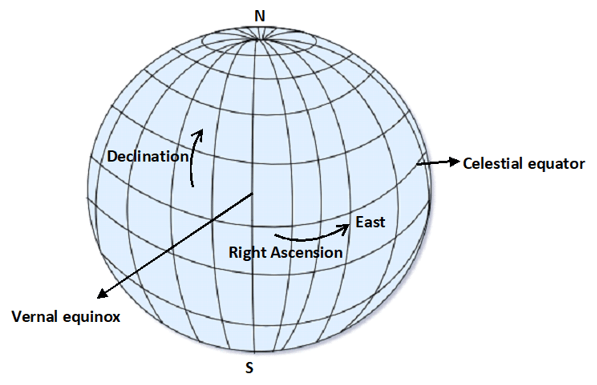This set of Orbital Mechanics Multiple Choice Questions & Answers (MCQs) focuses on “Celestial Sphere”.
1. Where does the origin exist on the celestial equator for measuring the longitude?
a) Greenwich
b) Vernal equinox
c) Intersection of ecliptic and equatorial planes
d) Ephemeris
View Answer
Explanation: Vernal equinox lies on the celestial equator which is the outward projection of Earth’s equator on the celestial sphere. This is the origin for measuring the longitude which is done is degrees from east to west.
2. On the celestial sphere, what are latitudes also known as?
a) Right Ascension
b) Declination
c) Inclination
d) Meridian
View Answer
Explanation: On the celestial sphere, latitude are nothing but the declination since the positive latitudes run from equator to the north pole, and the negative values run from equator to the south pole. These are measure in degrees.

3. What are the coordinates of celestial body as a funtion of time known as?
a) Ephemeris
b) Zenith
c) Sidereal
d) Celestial coordinates
View Answer
Explanation: The coordinates of celestial body which includes stars, comets, asteroid, planets etc. are known as ephemeris when its coordinates are expressed as a function of time. The ephemeris depends on epoch or vernal equinox at that time.
4. In which direction does the celestial sphere appear to move in?
a) West to East
b) East to West
c) North to South
d) South to North
View Answer
Explanation: Due to the Earth’s rotation which is in the direction of East to West, the celestial sphere also rotates East to West as it is just a fictious sphere with Earth’s centre as its own.
5. What is the point which is vertically overhead the observer on the celestial spehere called?
a) Nadir
b) Azimuth
c) Zenith
d) Horizon
View Answer
Explanation: Zenith is the point on the imaginary celestial sphere which is directly overhead the observer. It is the highest point on the sphere and this is the point when the shadows appear to be at its smallest when Sun is at the zenith.
6. What is the point which is vertically below the observer on the celestial spehere called?
a) Nadir
b) Azimuth
c) Zenith
d) Horizon
View Answer
Explanation: Nadir is the point on the imaginary celestial sphere which is directly below the observer. It is directly opposite to the Zenith. Usually when the astronauts carry out spacewalks, they refer to nadir which is the downward view of the satellite in the orbit.
Sanfoundry Global Education & Learning Series – Orbital Mechanics.
To practice all areas of Orbital Mechanics, here is complete set of 1000+ Multiple Choice Questions and Answers.
If you find a mistake in question / option / answer, kindly take a screenshot and email to [email protected]
